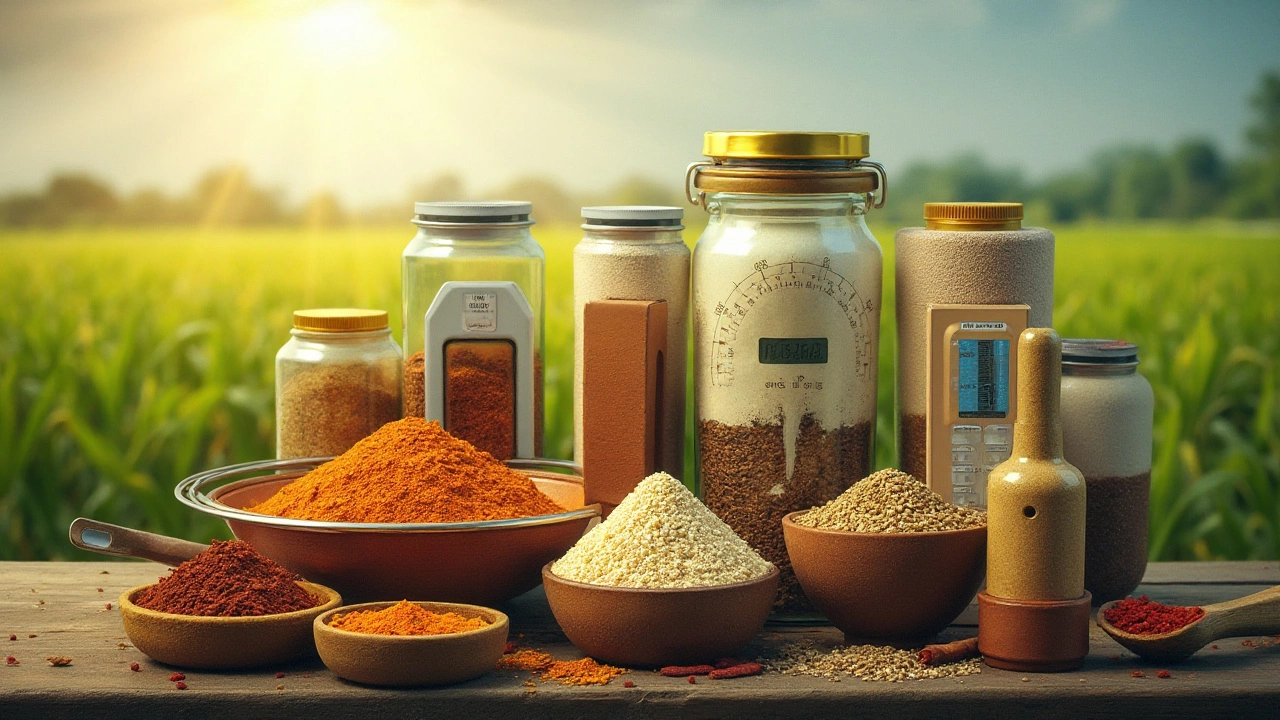In the intricate world of food processing, precision becomes paramount. The units of measurement used can spell the difference between a delightful concoction and a culinary disaster. Throughout history, humans have developed a variety of units to fit the diverse needs of food production, from small-scale kitchen endeavors to massive industrial operations.
Whether you're an aspiring gourmet chef or a burgeoning food industry mogul, understanding these units is crucial. They not only influence taste and texture but also ensure safety and uniformity. Join us as we delve into ten essential measurements that shape the flavor and quality of what we eat every day.
Grams and Kilograms
When it comes to the language of mass and weight in food processing, the gram and kilogram reign supreme. These units of measurement are indispensable across culinary spheres, providing the precision that home cooks and industrial giants alike demand. While grams handle the finesse of tiny portions, kilograms are used for more substantial quantities. In fact, the kilogram is often the staple unit in food production settings due to its balance of detail and tangibility.
Why Grams Fit the Bill
The gram, a minuscule yet mighty unit, is crucial for measuring spices, flavor enhancers, and other ingredients where small variances can impact taste profoundly. Need a pinch of saffron or a specific amount of baking powder? The gram ensures you're adding just enough without tipping the balance.
The Versatility of Kilograms
On the larger end of the scale lies the kilogram, a unit boasting more heft while maintaining the necessary detail required for food production. Think about the bakery that must consistently produce five-kilogram batches of dough, or a brewery that handles hundreds of kilograms of grains. The kilogram bridges the gap between precise measurement and practicality.
A Global Perspective
While certain places like the United States still frequently lean on ounces and pounds, the gram and kilogram have become the international standard. They provide a universal language, helping to prevent misunderstandings in ingredient measurement when products are traded globally.
| Ingredient | Weight in Grams | Weight in Kilograms |
|---|---|---|
| Flour (per cup) | 120g | 0.12kg |
| Sugar (per cup) | 200g | 0.2kg |
| Butter (per stick) | 113g | 0.113kg |
As culinary science continues to evolve, so too does our reliance on the **gram** and **kilogram**. These measurements remain pillars in achieving the flavors and standards people have come to expect from their favorite foods.
Liters and Milliliters
The metric system has revolutionized how we measure food processing units, with liters and milliliters being the cornerstone of liquid measurement. Used ubiquitously across the globe, these units provide a universally accepted standard, ensuring consistency and accuracy in recipes and production processes.
Known for their precision, milliliters are often employed in the preparation of sauces, dressings, and specialty drinks. For instance, when crafting a fine vinaigrette, each milliliter counts, balancing oil and vinegar to harmony.
Understanding the Importance
Why are liters and milliliters so crucial? Quite simply, they bridge the gap between recipes and reality. Imagine formulating a batch of lemonade for a summer festivity. Here, a liter jug becomes your trusted companion, allowing for scalable recipes and convenient scaling to larger volumes without sacrificing flavor or consistency.
Conversions and Practical Usage
For those ingrained in the imperial system, converting these units is second nature. 1 liter equates to 1000 milliliters, or approximately 4.2268 cups. This straightforward conversion aids chefs and processors in adapting and adjusting recipes that demand meticulous precision.
Quick Conversion Table
| Liters | Milliliters | US Cups |
|---|---|---|
| 0.5 | 500 | 2.113 |
| 1 | 1000 | 4.2268 |
| 2 | 2000 | 8.4536 |
As food production evolves, so does the necessity for these units. High-speed machinery in factories often requires exact liquid measurements to ensure each packaged product meets stringent quality standards. Imagine a yogurt plant without this level of precision—an errant milliliter could alter texture, flavor, and customer satisfaction.
Embracing liters and milliliters extends beyond industry and into our everyday lives. From the home cook meticulously measuring broth for a risotto to the commercial entity producing thousands of bottles of soft drinks, the importance of these units cannot be overstated. Mastery over these measurements empowers individuals and companies alike to deliver perfect results consistently.

Cups and Tablespoons
For generations, the humble cup and tablespoon have been the unsung heroes of countless kitchens, offering a bridge between tradition and precision. Despite the simplicity of these units, their impact on food processing can't be overstated. Let's dig into how these measurements elevate your cooking and ensure consistency, whether in a cozy home kitchen or a busy commercial setup.
Why Use Cups and Tablespoons?
The cup, most commonly recognized as 240 milliliters in the United States, offers a convenient way to measure larger quantities. On the other hand, the tablespoon, approximately 15 milliliters, is ideal for finer measurements. Together, they form a duo that handles a wide range of ingredients, from dry to liquid, with surprising accuracy.
Standardizing Recipes
In any food production line, consistency is key. The variation in ingredient proportions can lead to significant differences in flavor and texture, which is why cups and tablespoons are essential. These units enable replicable results by providing a shared standard, regardless of who prepares the dish.
Converting with Ease
Understanding conversions between these units can be incredibly useful. Here are some fundamental conversions:
- 1 cup = 16 tablespoons
- 1 tablespoon = 3 teaspoons
Such conversions are especially important in food production, where adjusting recipes to scale up or down is often required.
Interesting Facts and Tips
Did you know that the concept of the tablespoon dates back to the 18th century? It was an era where cooks eyed measurements rather than precision tools. Moreover, today's measuring cups often include standardized markings for both metric and imperial units, making them versatile tools in any culinary arsenal.
When baking, remember to level off dry ingredients in a cup to avoid over-packing, which could lead to inaccurate measurements and ultimately, differing flavors or textures. Liquid ingredients should always be measured at eye level in a clear measuring cup, ensuring you're capturing the right amount.
Embrace the classic charm of cups and tablespoons in your food processing adventures, and don't hesitate to use these units to experiment and explore new flavors while maintaining the balance and integrity of your recipes.
Ounces and Pounds
In the culinary landscape, the ounce and pound are measurement units that play a significant role in both food processing and day-to-day cooking. As part of the Imperial system, or rather its descendant—the U.S. customary units—these measures are predominantly used in the United States and often accompany recipes and packages you encounter in everyday life.
Understanding the Basics
An ounce (oz) weighs precisely 1/16 of a pound and is commonly used to measure small quantities of ingredients or individual portions. For larger quantities, the pound (lb), equivalent to 16 ounces, takes the front seat. This dual presence offers flexibility, accommodating both finer precision and more extensive bulk measures.
Imperial Vs. Metric
When juxtaposed with their metric counterparts, ounces, and pounds reveal intriguing contrasts. A single ounce equals approximately 28.35 grams while a pound is about 0.453592 kilograms. Although primarily used in the United States and, to a lesser extent, in countries like Canada and Australia, many global food operations necessitate conversions to grams and kilograms, particularly during international trade.
Application in Food Production
When it comes to industrial food production, ounces and pounds simplify ingredient batching, inventory management, and nutrition labeling. In retail settings, from deli counters to bulk food stores, these units lead transactions. By standardizing these units, producers ensure consistency and quality, bolstered by easily interpretable measures for consumers.
Fun Facts and Tips
- The troy ounce, used primarily for precious metals, differs from the regular ounce; it's slightly heavier at approximately 31.1 grams.
- In the baking domain, an ounce of dry flour weighs less than an ounce of wet ingredients like honey, reminding bakers to consider density in their measurements.
- An age-old tip: A pound has 16 ounces, not 12, which differs from the more intuitive 12-hour clock convention!
While the metric system often overshadows the Imperial scales globally, ounces and pounds retain their unique charm in food processing, shaping how ingredients are measured, recipes are crafted, and dishes are perfected, from gourmet delights to mass-scale productions.

Bushels and Pecks
When it comes to measuring quantities in bulk, particularly for grains, fruits, and vegetables, units like bushels and pecks are indispensable. These age-old measurements have roots deeply planted in agricultural traditions, yet they still hold relevance in modern food processing and market settings.
A Brief History
The term 'bushel' originates from the Middle English 'busshel,' reflecting a volume-based measurement. Traditionally, a bushel represented the capacity of a cylindrical container, standardized to 8 dry gallons or roughly 35.24 liters in the U.S. and 36.37 liters in the U.K. Similarly, a peck is one-fourth of a bushel, translating to approximately 8.81 liters. Originally used for cereal grains, their usage extended to other produce over time.
Practical Applications in Food Processing
In today's food production, bushels and pecks often come into play during the initial stages, dealing with raw inputs like apples, corn, and potatoes. They are vital for farmers and buyers at markets, providing a consistent measurement for price determination and logistics.
In a fascinating alliance between tradition and practicality, some industries opt for bushels when packaging heavy or voluminous items, ensuring an understanding based on historical precedent. For instance, a bushel of wheat weighs around 60 pounds, whereas a bushel of oats only weighs about 32 pounds—showing how a single unit can differ greatly in weight depending on the product.
Tips for Conversion
Understanding conversions can be crucial for small-scale producers or agriculture enthusiasts who deal with these units:
- 1 bushel = 4 pecks = 8 dry gallons
- 1 peck = 2 dry gallons = 8 dry quarts
When transitioning from traditional to metric measurements, it's important to remember that these conversions can help ensure accuracy and consistency across different scales of production.
Although more modern systems may have overshadowed bushels and pecks in some settings, their presence in historical records, traditional recipes, and certain modern markets reminds us of the enduring connection between food production and cultural heritage. By maintaining a comprehensive understanding of these units, both producers and consumers can appreciate the depth and intricacy involved in the journey from farm to table.
